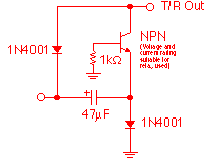Increasing Amplifier Relay Speed
Bob Wolbert, K6XX

Read a high-resolution, printer compatible PDF version instead of this HTML.
The first element of all of my transmissions was shortened when running the amplifier. Worse, the transmitter ALC swung high, which automatically reduced transmitter power for several seconds. Both problems were traced to a slow acting T/R relay in the amplifier.
The circuit (Figure 1) speeds the relay by blasting it with twice the normal coil voltage when first activated. The coil voltage decays to normal within a few milliseconds (decay time is proportional to the capacitor size; 47µF is a good starting point). This circuit was designed by Tony, K1KP.
This circuit only does its magic with amplifiers that switch a relay coil to transmit. Also, the relay must use a DC coil. Suitable amplifiers include the Drake L4B and L7, Ameritron amps, and the TL-922.
Does this harm the relay? I don't think so. For example, W6CYX has modified the relay supply voltage in his TL-922 (which has an exceptionally sluggish relay) so that it is double its design voltage full time. He has run it every day for several years without problems.
After adding these parts to the T/R cable from the rig to the amplifier, my AL-1200 no longer truncates leading dots, even at high speed. If your amplifier has slow T/R switching, try installing this simple circuit in the T/R line!

Figure 1. Relay Accelerator Speeds Your Amplifier
Circuit Operation
When the amplifier is initially powered up, the T/R Out voltage rises, charging the capacitor through both diodes. When T/R In is pulled low (to about zero volts), the emitter of the NPN transistor suddenly falls to a negative voltage--nearly equal in magnitude to the open key voltage (VOPEN) on T/R Out. The transistor turns ON and the instantaneous voltage on T/R Out is VOPEN. The relay coil sees twice VOPEN across it and closes faster than normal. As soon as the capacitor discharges, the relay coil only sees VOPEN, so coil power dissipation remains normal.
When T/R In goes high, T/R Out stays low only until the capacitor charges up againa very short while. The 1k base resistor is needed to prevent the transistor from clamping the negative spike to only 0.7V (and also avoids destructively high base currents).
Before you select a transistor, measure VOPEN and the short-circuit (key down) current through T/R Out. The Ameritron relays generally run 12V at about 100mA. The L4B switches 50V at 50mA. Make sure your transistor can handle both the open circuit voltage and the short circuit current. The capacitor must have a voltage rating above VOPEN.